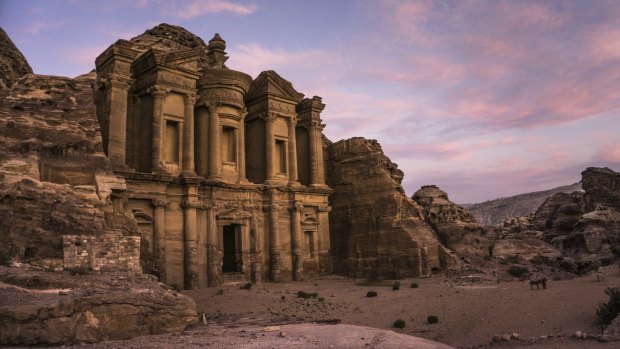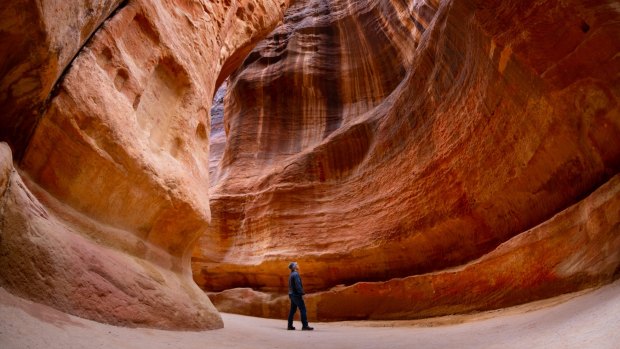This was published 4 years ago
Jordan's Petra is still a revelation for the jaded tourist
By Keith Austin

The magnificent monastery located on the top of Petra, at sunset.
It's one of the great reveals of the world – the last turn through the Siq, the deep, narrow fissure which snakes through the sandstone cliffs that make up the entrance to Petra, Jordan's famous Lost City.
Our guide makes us take a moment before we get there. Hold hands and close your eyes, he orders, and leads us around a corner like a group of children on a school outing.
We open our eyes and there it is, the famous Treasury building, its pale pink facade framed by the sensuous, wavelike formation of the Siq. Sometimes these things can be a disappointment. There are places whose reputations have been blown out of all proportion so that when you get there it's just a bit, "meh".

Inside the lost city of Petra.Credit: iStock
Burt not here. This is truly an "oh my gosh" moment.
Of course, Petra isn't lost any more. Far from it. Indiana Jones galumphed around here in The Last Crusade, giant robots traipsed through it in Transformers: Revenge of the Fallen, and more than a million very human tourists visited in 2019, up from 800,000 in 2018.
Not bad for a place that had effectively disappeared and was only rediscovered in 1812 by Swiss adventurer Johann Ludwig Burckhardt. In his 1822 book, Travels in Syria and the Holy Land, he wrote: "An excavated mausoleum came in view, the situation and beauty of which are calculated to make an extraordinary impression upon the traveller, after having traversed for nearly half an hour such a gloomy and almost subterraneous passage..."
Leaving aside the question of exactly how you lose a whole city the real revelation is just how much there is to see beyond the Treasury. Follow the path to the right and you emerge in an expansive valley honeycombed with mausolea. There's even a large, Roman-style amphitheatre.
At ground level and up above in the cliff faces, the soft sandstone has been carved and excavated, the layered swirls of the Neapolitan-ice-cream-coloured rock transformed into hand-hewn caves, temples and tombs.
It was a bunch of nomadic traders and merchants called the Nabateans who established the city, then known as Raqmu, as the capital of a precociously innovative and cultured empire in the 4th century BC. At its height, some 20,000 people lived here.
Naturally, this came to the notice of the busybody Romans, who, after many hundreds of years of unsuccessful military campaigns, finally annexed Nabatea and it became part of the Roman Empire in 106 AD.
We are lucky enough to visit the site twice, arriving both times early in the morning to beat the crowds and the heat. There are Roman ruins, a Byzantine church (with some particularly spectacular mosaics), and the startlingly intact remains of structures such as the monumental Great Temple, the Qasr al-Bint Temple and Ad-Deir, the massive rock wall monastery at the summit of a nearby hill.
Reached via 850-plus steep and uneven steps carved out of the rock, it isn't a climb for the faint of heart but it's worth it. The monastery is dazzling – possibly more so than its more famous cousin, the Treasury – and you can admire it from the cushioned seats of the small cafe-cum-restaurant which does a roaring trade flogging cold drinks and sweet mint tea to sweaty travellers.
There's still a bit of a climb after this if you want to reach the highest point of the hill, from which you can experience what a sign calls "the best view in the world". I'm told it's very nice.
Emirates flies to Queen Alia international airport, Amman, from all major airports via Dubai. See emirates.com
STAY
The four-star Petra Guest House Hotel is right by the entrance to the site. See guesthouse-petra.com
TOUR
World Expeditions' 10-day Jordan Trail Highlights tour costs from $4870 a person, twin share and is 100 per cent carbon offset. Included are day treks, 4WD jeep tour, seven nights in hotels and guesthouses, two nights in Bedouin camps and most breakfasts, lunches and dinners. Places visited include Wadi Rum, Petra, Dana Nature Reserve, Jerash and the Dead Sea. See worldexpeditions.com
Keith Austin was a Guest of World Expeditions.
Sign up for the Traveller Deals newsletter
Get exclusive travel deals delivered straight to your inbox. Sign up now.